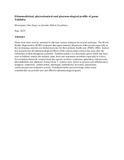| dc.description.abstract | Plants have been used by mankind to alleviate various ailments for several millennia.
The World Health Organization (WHO) estimates that approximately 80 percent
of the people especially in the developing countries use herbal medicine for their
primary health care (WHO, 2002). Interest and research into the pharmacological
effects of the various plant extracts has risen after the realization of their therapeutic
potential. Toddalia asiatica is a monotypic genus which has been used as folklore
remedy for malaria, pain, fever and respiratory problems especially in Africa.
Several phytochemicals isolated from this species includes coumarins, quinolines,
triterpenoids, phenanthridine and alkaloids. Extract from T. asiatica were shown to
possess anti-inflammatory, analgesic, antipyretic, antimicrobial, antifungal, antimalarial,
larvicidal, spasmolytic, cardiovascular and antitumor activity. Traditional herbs
and knowledge when tested scientifically can provide new and effective pharmacological
agents. | en |

